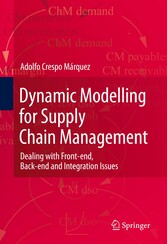Suchen und Finden
Service
Dynamic Modelling for Supply Chain Management - Dealing with Front-end, Back-end and Integration Issues
Adolfo Crespo Márquez
Verlag Springer-Verlag, 2010
ISBN 9781848826816 , 297 Seiten
Format PDF, OL
Kopierschutz Wasserzeichen
Geräte
Foreword
6
Preface
8
Acknowledgements
10
Contents
12
Part I An Introduction to Dynamic Modelling for Supply Chains
18
1 On the Definition of Dynamic Simulation
19
1.1 An Introduction to Dynamic Simulation
19
1.2 Time Handling in Dynamic Simulation Models
21
1.3 Deterministic and Stochastic Simulation
23
1.4 Dynamic Modelling Methodology and Tools
23
1.5 Model Validation vs Usefulness
28
1.6 Dynamic Modelling Approach Followed in this Book
29
1.7 References
31
2 Current Supply Chains Management Issues
32
2.1 Current Issues in SCM
32
2.2 SCM Issues and Related Problems
32
2.3 Network Configuration and Competition
33
2.4 Sharing Information Through ICTs
36
2.5 Developing Collaborative Planning Activities
39
2.6 Suppliers Management. Expanding the Purchasing Role
43
2.7 Approaching Markets Differently
44
2.8 References
44
3 Models for SCM Simulation and Analysis
47
3.1 SCM and Dynamic Simulation
47
3.2 Continuous Time Simulation Models for SCM
49
3.3 Classifying Hi-tech SC Dynamic Models in this Book
50
3.4 References
54
Part II Modelling Front-end Issues in SCM
56
4 Understanding a Customer’s Decision to Buy
57
4.1 Selecting Potential Markets
57
4.2 A Case Study for Market Segmentation
58
4.3 The Monitor Purchase Process. A Case Study
63
4.4 Concluding Remarks
67
4.5 References
67
5 Understanding Financial Implications of Strategy
69
5.1 Overview
69
5.2 The Price as Source of Revenue Stream
69
5.3 The Cost Structure and the Value Chain
74
5.4 The Value-driven Planning Process. A Case Study
78
5.5 References
85
6 Understanding Hi-tech Business Growth
86
6.1 Characterising Hi-tech Business Planning Process
86
6.2 Hi-tech Business Growth. A Case Study
88
6.3 References
95
7 Modelling a Hi-tech Business Growth
96
7.1 Model Overview
96
7.2 Modelling Customer’s Decision To Buy
97
7.3 Modelling a Customer Perception of a Product
99
7.4 Modelling Competition. Value Provided and Perceived
100
7.5 Modelling Marketshare, Revenue, Gross and Net Operating Profit
101
7.6 Modelling Profit Contribution Growth
104
7.7 Transforming a Dynamic Simulation Model into a DSS
108
7.8 Sample DSS and Case Study
109
7.9 Managerial implications
113
7.10 Conclusions and Further Research
115
7.11 References
115
Part III Modelling Back-end Issues In SCM
117
8 Back-end Issues Related to Supplier Management
118
8.1 Contract Structures for Supplier Management
118
8.2 Competitive Prourement Strategies: Global and Multiple Sourcing
118
8.3 Types of Contractual Relationships with Suppliers
119
8.4 Procurement Risk Management at HP. A Case Study
121
8.5 References
128
9 Modelling a Portfolio of Contracts with Suppliers
129
9.1 Overview
129
9.2 Formal Characterisation of the Contracts with Suppliers in a Dynamic Volatile Business Environment
130
9.3 Modelling Accountability of the Procurement System
138
9.4 Modelling Forward Contract with Suppliers
141
9.5 Modelling Commodity Options Contracts with Suppliers
143
9.6 Selecting a Suitable Contract Portfolio with Suppliers
144
9.7 Managerial Implications of the Work
149
9.8 Concluding Remarks of the Chapter
151
9.9 References
151
10 Modelling Back-end Issues in Manufacturing
152
10.1 Introduction to the Modelling of Manufacturing Issues
152
10.2 Case Study in Semiconductor Fabs
153
10.3 Introduction to the Case Study
153
10.4 Pros and Cons of LP Models to Deal with PM Scheduling
155
10.5 Dynamic Simulation to Deal with PM Scheduling in Fabs
158
10.6 Modelling Preventive Maintenance Policies
161
10.7 Specific Wafer Production Flow Scenarios
165
10.8 Simulation Results
168
10.9 Concluding Remarks of the Case Study
173
10.10 References
173
Part IV Modelling Integration Issues in SCM
175
11 Different Supply Chain Integration Models
176
11.1 SC Integration Opportunities
176
11.2 Characterisation of SC Materials and Information Flows
184
11.3 Modelling a Non-integrated Supply Chain
187
11.4 Modelling PI SC with Sharing Sell-through
188
11.5 Modelling PI SC with Shared Inventory Information
188
11.6 Modelling Integrated (Sales and Inventory) Supply Chains
189
11.7 Results About Integration Sequence Implications
189
11.8 Concluding Remarks
191
11.9 References
192
12 Modelling Financial Implications of Integration Strategies
194
12.1 An Introductory Case Study
194
12.2 Modelling Materials, Information and Financial Flows
199
12.3 Integration with Financial Limitations
202
12.4 Results with No Financial Limitations
205
12.5 Integration with Financial Limitations for All Nodes
205
12.6 Financial Limitations at a Single Node
210
12.7 Concluding Remarks
210
12.8 References
211
13 Exploring the Use of Manufacturing Control Techniques in Virtual SC
212
13.1 Virtual Manufacturing in Modern Supply Chains. Comparing SC Integration Levels to Push- Pull Manufacturing Schemes
212
13.2 Hybrid Push-pull Manufacturing Schemes Used for SCM
213
13.3 Sample CONWIP Driven Virtual Supply Chain
213
13.4 References
238
Part V Dynamic Modelling Projects
274
16 Presenting SCM Dynamic Simulation Projects
275
16.1 The Project Alternatives
275
16.2 One Point Solution
276
16.3 Decision Improvement Process
276
16.4 Infrastructure Solution
277
16.5 Organisational Independence
277
16.6 Combination of Alternatives
277
16.7 A Modelling Value Proposition. A Case Study
280
17 Capturing the Learning of a Modelling Project
284
17.1 The Project Technical Closure
284
17.2 The Project Technical Closure Case Study
286
17.3 Reference
290
Index
291
Service
Shop



